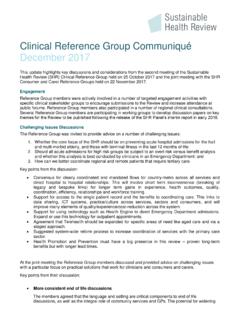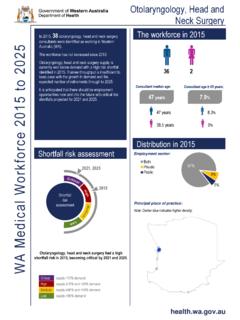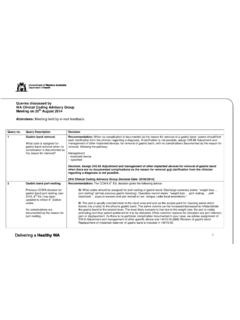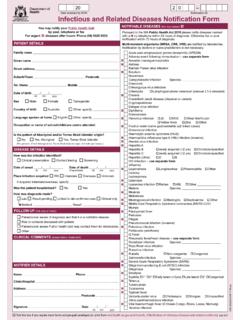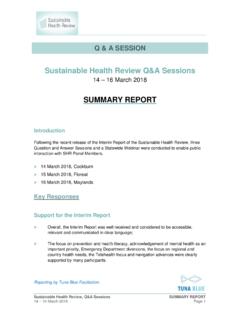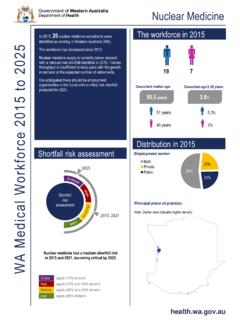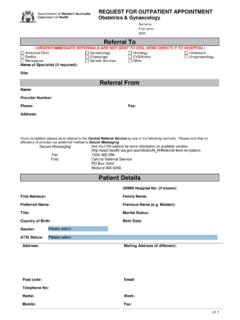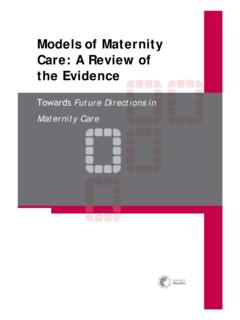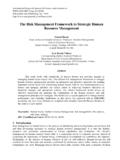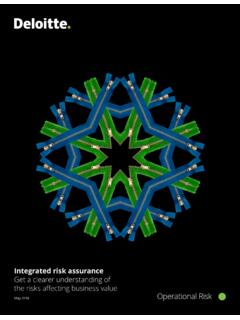Transcription of Clinical Risk Management Guidelines - Department of Health
1 Clinical Risk Management Guidelines A best practice guide Owner: Department of Health , Western Australia Contact: Patient Safety Surveillance Unit (PSSU) Department of Health 189 Royal St East Perth, WA 6004 Version: Approved by: Dr A. Koay Executive Director PSCQ Date: 26/11/2019 Important Disclaimer: All information and content in this Material is provided in good faith by the WA Department of Health , and is based on sources believed to be reliable and accurate at the time of development. The State of Western Australia, the WA Department of Health and their respective officers, employees and agents, do not accept legal liability or responsibility for the Material, or any consequences arising from its use. Contents Key Definitions 1 Introduction 2 What is Clinical risk Management ?
2 2 What is risk? 3 Why manage risk? 1 Purpose of Clinical Risk Management Guidelines 2 Clinical Risk Management Process 3 Communication and Consultation 4 Step 1 Establish the context 5 Defining the scope 5 Establish the context 5 Step 2 Identify the risks 7 Categorisation of risk 9 Step 3 Analyse the risks 12 Types of analysis 12 Determining the adequacy of existing controls 13 Consequences of Clinical risk 14 Likelihood of the risk 15 Determining the level of Clinical risk 15 Step 4 Evaluate the risks 18 Clinical risk evaluation 18 Roles and responsibilities 18 Determining acceptability of Clinical risk 18 Step 5 Treat the risks 21 Treatment options 21 Evaluating treatment options 22 Preparing treatment action plans 23 implementing treatment action plans 23 Monitor and review 27
3 Implementation of Clinical Risk Management 29 References 30 Appendix A Glossary 31 Appendix B Risk categories and areas of risk 34 Appendix C Example Risk Management Measures 36 1 Key Definitions The following key definitions are used in the Clinical Risk Management Guidelines : Consequence is an outcome of an event affecting objectives. It refers to the outcome or impacts of an event expressed qualitatively or quantitatively, being a loss, injury, disadvantage or gain. There may be a range of possible outcomes associated with an event. Control A measure that maintains and/or modifies risk. Controls include, but are not limited to, any process, policy, device, practice, or other conditions and/or actions which maintain and/or modify risk. Controls may not always exert the intended or assumed modifying effect.
4 Controls may be preventative whereby a control prevents the cause of a risk or mitigative whereby the consequences of a risk are reduced. Likelihood is a chance of something happening and refers to a qualitative description of probability or frequency. Risk Management System means the organisational structure, procedures, processes and resources needed to manage Clinical and corporate risk and to monitor organisation s performance and outcomes. ERMS The enterprise risk Management system used by the WA Health system Risk Risk is the effect of uncertainty on objectives (either positive or negative). Clinical Risk refers to risks associated with delivering Clinical functions Corporate Risk refers to risks associated with providing corporate functions Residual Risk refers to the remaining level of risk after the risk treatment process has been completed.
5 Risk Treatment refers to the selection and implementation of appropriate Management options for dealing with identified risk. Stakeholders are those people and organisations who may affect, be affected by, or perceive themselves to be affected by, the decision or activity. Standard refers to the Australia/New Zealand Standard on Risk Management AS/NZS ISO 31000:2018. WA Health refers to the whole of the WA public Health system, particularly the Department of Health , Health Service Providers and their hospitals. Department of Health refers to the system Management of WA Health located at Royal St, East Perth. Organisation refers to a hospital or Health Service Provider or other designated public Health provider. An expanded list of terms is available in the Appendix A Glossary.
6 2 Introduction What is Clinical risk Management ? Health care services are provided to patients in an environment with complex interactions among many factors, such as the disease process itself, clinicians, technology, policies, procedures, and resources. When these complex factors interact, harmful and unanticipated outcomes ( errors) can occur resulting in unintentional harm to a As illustrated in the examples above, Clinical risk Management is an ongoing process for judging risk and subsequently making appropriate Clinical plans for the patient considering the risks It is a daily activity of all staff involved in Clinical care. Clinical risk Management is about minimising risks and harm to patients by: identifying what can and does go wrong during care understanding the factors that influence this learning lessons from adverse events ensuring action is taken to prevent recurrence putting systems in place to reduce risk Why is Clinical risk Management important for all clinicians?
7 In Clinical practice there are a lot of things that can contribute to effective patient outcomes. One of the most important things is avoiding unintentional harm to the patient. Patients trust clinicians and expect that hospitals will be safe, caring environments which will contribute positively to improving their Health , and that is why risk identification and Management is so important. Risk Management often requires busy clinicians to take a step back and not just look at the patients under their care, but also at the processes, structures and environment within which they provide this care. This process enables staff to identify vulnerabilities and take corrective action when they see an unsafe situation or environment. For example, taking steps to ensure a slippery floor is dry and preventing a patient, visitor or another staff member from falling over is as important as ensuring that the medication a patient is taking is the correct one.
8 Furthermore, who would think that there is a risk of drowning in a hospital? But there is this risk when the physiotherapy Department operates a hydrotherapy pool. Could a young child waiting with their parent wander into an unattended and unsecure pool facility? What plans are in place as control measures to stop this child from drowning? Are these adequate? What is the risk rating? These are the type of questions that should be considered for all of our areas of Clinical practice. These Guidelines will assist all clinicians to understand the importance of identifying hazards and areas of Clinical risk as we work to keep our patients safe and prevent unintended harm. 3 Clinical risk Management is part of a good Clinical governance system through which organisations are accountable for continuously improving the quality of their services and safeguarding high standards of care.
9 As outlined in the Clinical Governance, Safety and Quality Policy Framework3, this is achieved by creating an environment in which there is transparent responsibility and accountability for identifying and managing risks , issues and opportunities so that excellence in Clinical care may flourish. What is risk? The Australian/New Zealand Standard AS/NZS ISO 31000:2018 defines risk as the effect of uncertainty on risks are measured in terms of consequence and likelihood. risks can be classified into the categories as outlined in Figure 1. Figure 1: Risk categories As indicated in Figure 1, Clinical and corporate risks can cross over and impact on both Clinical and corporate functions. The WA Health system is exposed to many Clinical and corporate risks on a daily basis as can be illustrated in Appendix B Risk Categories and areas of risks .
10 These risks may arise from: Risk - the effect of uncertainty on objectivesClinical - risks associated with delivering Clinical functionsCorporate- risks associated with providing corporate functionsStrategic risks in relation to overarching direction of the organisation Usually identified and managed at an executive level and part of the strategic planning processOperational risks in relation to day-to-day delivery of services /activities in the organisation Usually identifed and managed at the specific division areaProject risks in relation to the activities in the project lifecycle Usually identified and managed within the project team 1 provision of Health care and its related activities operational Management activities and control human behaviour commercial and legal
